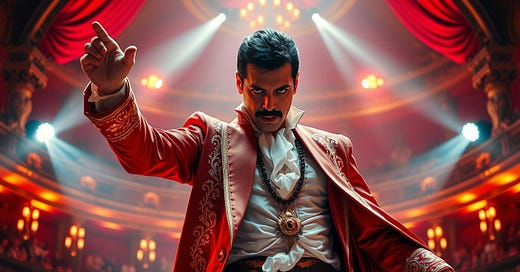Music & AI: How I Made Freddie Mercury Sing a Baroque Aria
If it moves you, does it matter that it's not real?
There is a magical moment when technology becomes poetry when algorithms transform into brushes capable of painting unexpected emotions. It happened just like that, on an afternoon when my passion for baroque music intersected with the disruptive potential of artificial intelligence.
It all began with "Alto Giove," a sublime aria by Nicola Porpora, one of the greatest composers of the Neapolitan school of the eighteenth century. I'm not discovering anything new, let me be clear. "Alto Giove" is already universally recognized as one of the baroque musical landscape's most beloved and celebrated arias. But for me, who until a few months ago had a passion for classical music but didn't follow it with today's continuity and depth, this piece was a true revelation. It captivated me, struck me by its delicate complexity. Every note vibrated with a melodic power and intensity that completely won me over.
Boundaries
What if Freddie Mercury had been able to interpret this piece? The Queen frontman, a rock icon who redefined the boundaries of popular music, lending his extraordinary voice to a baroque aria? The idea soon became a creative obsession, an experiment that challenged the boundaries between genres and epochs.
The artificial intelligence tools available online today became my allies in this adventure. I began by isolating what I consider the ritornello of ‘Alto Giove’—which starts at 1:32 and recurs at 6:45 in the video I shared—from Philippe Jaroussky’s performance, as these passages are structurally and expressively vital to the work.
Listen to Philippe Jaroussky's performance of "Alto Giove" by Nicola Antonio Porpora:
Then, through a series of technical elaborations - key changes, audio manipulation, application of voice recognition and reconstruction algorithms - I began to "dress" that baroque melody with Mercury's voice.
The result was more than a simple experiment—it was true sonic alchemy. Freddie's voice, with its rock charge and incredible range, miraculously merged with Porpora's aria's elegant and complex structure. It wasn't an overlay but a true musical re-narration.
To make the experience even more immersive, I inserted the frenzied audience at the end of the performance. An ovation that could seal this particular fusion between baroque and rock, which are perhaps two sides of the same coin in their ability to ignite hearts.
Experiment
Freddie Mercury sings "Alto Giove" by Nicola Porpora
I want to be clear: I'm not trying to prove anything with this humble, rustic experiment. It's not proof, it's not a thesis. It's simply an invitation. An invitation to curiosity, to discovery, to look beyond the boundaries we often artificially construct between past and present, between the so-called "high" and "low" culture, and between tradition and innovation.
Of course, you'll tell me it's all fake: I'm fully aware of that. Is it possible that everything related to AI must be resolved totally in the contradiction between true and false, without leaving space for what can be unifying, and binding?
Beyond the technical aspect, this experiment encapsulates for me a message about our relationship with culture and history. Artificial intelligence isn't just a tool, it's a bridge. A bridge that allows us to rediscover the past, to make it alive, to make it breathe with the same energy as the present.
Connections
The music of Nicola Porpora, like many artistic expressions of the past, isn't a museum artefact. It's a living language, capable of communicating universal and cross-cutting emotions. AI helps us translate these languages, and establish connections that go beyond temporal and stylistic boundaries.
I invite anyone reading me not to stop at the surface. Listen to baroque music, and let yourself be surprised by its complexity. Discover the Neapolitan school, with its revolutionary composers like Porpora. Every note is a story, every melody a universe of emotions just waiting to be explored.
Technology is our ally in this exploration. Not to replace art, but to amplify it, to make it accessible, to help it cross the boundaries we too often have imposed upon it.
Precisely because we know Mercury never sang Porpora, precisely because we are conscious of the artifice, the emotion experienced becomes a superior truth. It's proof that art doesn't live in matter (notes on paper, sound waves) but in the movement it creates between our synapses and our stomachs. It's an inner world
New meaning?
What is more "real" – the crystallized perfection of a past era, or the shiver that runs down our spine when two impossible worlds collide generating sparks of new meaning?
If an artifice moves us, the emotion is real, therefore art exists beyond the medium. Right? The answer, perhaps, lies precisely in that Mercury scream that insinuates itself between baroque volutes, transforming a sacred aria into a hymn to freedom.
It's the sound of a bridge collapsing – to reveal that there was no division between the rock spurs on which it rested. No separation.
Feel free to leave a comment.
I have woven tales for anyone who cares to read them. My books await you on Google Books. You can also check out my stories on Medium.com.
I am eager to participate in research and produce content on Cross-Cultural Philosophy. Considering the many philosophy professors following Learn Vedanta Substack from universities across the five continents, I would be truly honoured to be involved in projects, as I have been recently approached. Please feel free to contact me.
I would be honoured if you considered subscribing to the Premium Contents of my Vedanta Substack and leaving feedback, comments, and suggestions on this page and by writing to me at cosmicdancerpodcast@gmail.com.



